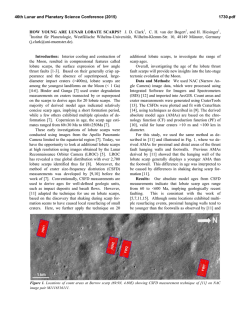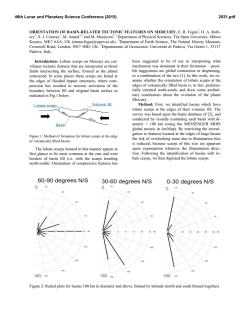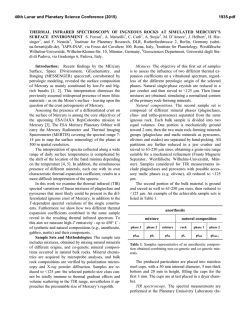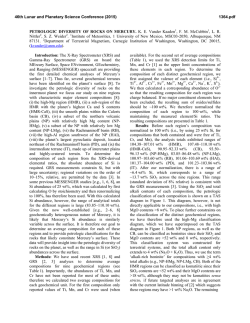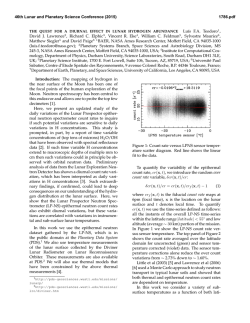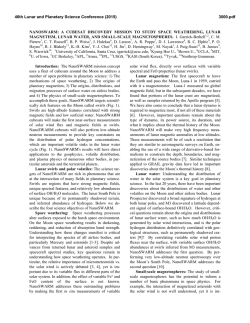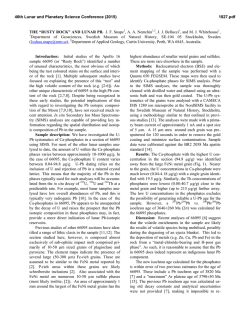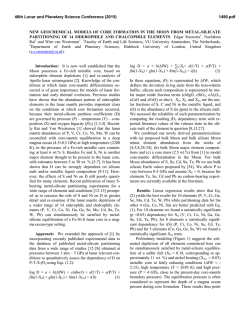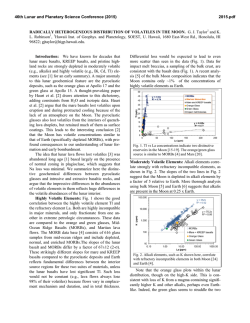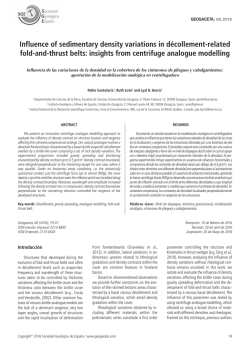
Small Thrust Fault Scarps on Mercury Revealed in - USRA
46th Lunar and Planetary Science Conference (2015) 2240.pdf SMALL THRUST FAULT SCARPS ON MERCURY REVEALED IN LOW-ALTITUDE MESSENGER IMAGES. Thomas R. Watters1, Sean C. Solomon2,3, Katie Daud1, Maria E. Banks1, Michelle M. Selvans1, Mark S. Robinson4, Scott L. Murchie5, Nancy L. Chabot5, Brett W. Denevi5, Carolyn M. Ernst5, Clark R. Chapman6, Caleb I. Fassett7, Christian Klimczak3,8, Paul K. Byrne3,9, David T. Blewett5, 1Center for Earth and Planetary Studies, National Air and Space Museum, Smithsonian Institution, Washington, DC 20560, USA ([email protected]); 2LamontDoherty Earth Observatory, Columbia University, Palisades, NY 10964, USA, 3Department of Terrestrial Magnetism, Carnegie Institution of Washington, Washington, DC 20015, USA; 4School of Earth and Space Exploration, Arizona State University, Tempe, AZ 85251, USA; 5The Johns Hopkins University Applied Physics Laboratory, Laurel, MD 20723, USA; 6Planetary Science Directorate, Southwest Research Institute, Boulder, CO 80302, USA;7Department of Astronomy, Mount Holyoke College, South Hadley, MA, USA; 8Department of Geology, University of Georgia, Athens, GA 30602, USA; 9Lunar and Planetary Institute, Houston, TX 77058, USA. Introduction: The MErcury Surface, Space ENvironment, GEochemistry, and Ranging (MESSENGER) spacecraft has confirmed that the tectonic history of Mercury since the late heavy bombardment is dominated by contraction [1-4]. The most broadly distributed contractional tectonic landforms on Mercury are lobate scarps, the surface manifestation of thrust faults [3,4]. These scarps are often hundreds of kilometers long and display hundreds to thousands of meters of relief. They are readily detected in images obtained by MESSENGER’s Mercury Dual Imaging System (MDIS) wide-angle and narrow-angle cameras, particularly in high-incidence-angle images and mosaics with pixel scales of 200 m [3]. Indeed, the scale of these prominent landforms facilitates their discrimination from other positive-relief features and their characterization with topography acquired from the Mercury Laser Altimeter (MLA) [5] and stereo imaging [6, 7]. Lowering MESSENGER’s periapsis altitude has provided the opportunity to image the surface of Mercury at higher resolution than was possible during the earlier orbital phase of the mission. In low-altitude images obtained at pixel scales as low as ~2 m/pixel, small lobate scarps have been detected. Dimensions of Small Scarps: The small scarps are less than 10 km in length (Fig. 1, 2), an order of magnitude or more smaller than their larger counterparts. The small scarps on Mercury are nonetheless comparable in scale to similar small scarps documented on the Moon [8, 9]. Although lunar scarps were first identified in the highest-resolution Lunar Orbiter photographs and in Apollo Panoramic Camera images, their density and distribution could not be determined because of limited coverage until images acquired by the Lunar Reconnaissance Orbiter Camera (LROC) Narrow Angle Cameras (NACs) at spatial resolutions of 0.5 to 2 m/pixel revealed a globally distributed population of previously undetected fault scarps [8]. Their morphology, linkage between scarp segments, along-strike reversals in vergence, and crosscutting relations all suggest that lunar scarps are generally the surface expression of thrust faults [8-12]. Forward modeling constrained by topographic profiles also supports the interpretation that the lunar scarps formed by thrust faulting [13]. An origin by downslope move- ment is possible for some instances, but the fact that the vergence direction of lunar scarps is often upslope favors a tectonic origin. Lunar scarps are found in mare basalt units, but the great majority occur in the lunar highlands. Small scarps on Mercury are similar in morphology to their lunar counterparts and share characteristics such as segment linkage, reversals in vergence, and upslope vergence, consistent with a tectonic origin for these landforms. Like lunar scarps, Mercury’s small scarps often occur in clusters (Fig. 1). An example of a cluster of at least three small scarps, the longest ~4.3 km in length, is found in intercrater plains (Fig. 1). Estimates of relief from shadow measurements of five small scarps indicate a range of ~10 to 90 m (with a mean of ~40 m), similar to the range in relief of the small scarps on the Moon [9]. Age of Small Scarps: Low-altitude MESSENGER images also reveal that the small scarps crosscut small impact craters. Small craters with diameters <100 m are transected or disturbed by many of the small scarps (Fig. 1B). Transected small craters <100 m in diameter on the Moon are Copernican (<~800 My) in age [8, 14], broadly equivalent to the Kuiperian period on Mercury [15]. The low relief, lack of superposed small craters, and pristine appearance support the inference that small scarps on Mercury are geologically recent, because small landforms are unlikely to survive for billions of years under steady meteoroid bombardment. Small lunar scarps are likely less than 50 My old on the basis of estimated rates of infilling of small, shallow graben in the back-scarp terrain [14]. A small scarp on Mercury with associated smallscale, back-scarp graben has been found (Fig. 2). Some of these graben are estimated to have maximum widths of ~40 m, comparable to the widths of small lunar graben [14]. The back-scarp graben on both bodies are likely the result of uplift and flexural bending in response to slip on the underlying scarp-related thrust fault [8, 14]. The cratering rate has been estimated to be a factor of ~3 greater on Mercury than on the Moon [16], so the rate of degradation of small landforms and rate of infilling of shallow graben on Mercury is expected to be comparably greater. Thus, thrust faults forming these scarps on Mercury could be much younger than 50 My, raising the possibility that some of these features are currently active. 46th Lunar and Planetary Science Conference (2015) Spatial Distribution: The global distribution of small scarps on Mercury cannot be determined because the highest-resolution, low-altitude images are confined to the northern hemisphere around MESSENGER’s periapsis latitude. However, small scarps have been found across a wide range of longitudes, suggesting that they are broadly distributed in the northern hemisphere. The scarps occur on both smooth plains and intercrater plains. The small scarps are likely the smallest members of a continuum in scale of thrust fault scarps on Mercury. Locations of Small and Large Lobate Scarps: High-resolution images of the large lobate scarps indicate that some of these features have been recently reactivated. For example, disturbed and crosscut small impact craters (<100 m in diameter) on the northwest segment of Carnegie Rupes point to recent activity on thrust fault segments on this prominent scarp system. Moreover, small scarps are found near Carnegie Rupes and may have accommodated localized contractional strain related to continued reactivation of the faults un- 2240.pdf derlying the larger structure. Most of the small scarps identified to date, however, are not found near larger, older lobate scarps. Those small faults that are distant from larger structures and resolvably tectonic in orgin provide evidence that Mercury is forming geologically young faults to accommodate the most recent phases of interior cooling and global contraction. References: [1] Solomon S.C. et al. (2008) Science, 321, 59–62. [2] Watters T.R. et al. (2009) Earth Planet. Sci. Lett., 285, 283–296. [3] Watters T.R. et al. (2013) LPS, 44, abstract 2213. [4] Byrne P.K. et al. (2014) Nature Geosci., 7, 301–307. [5] Zuber M.T. et al. (2012) Science, 336, 217–220. [6] Oberst J. et al. (2010) Icarus 209, 230– 238. [7] Preusker F. et al. (2011) Planet. Space Sci., 59, 1910-1917. [8] Watters et al. (2010) Science, 329, 936–940. [9] Banks et al. (2012) JGR, 117, E00H11, doi:10.1029/2011JE003907. [10] Schultz P.H. (1976) Moon Morphology, Univ. Texas Press, Austin. [11] Binder A.B. (1982) Earth Moon Planets, 26, 117-133. [12] Watters T.R. and Johnson C.L. (2009) in Planetary Tectonics, Cambridge Univ. Press, pp. 121-182. [13] Williams, N.R. et al. (2013) J. Geophys. Res. Planets, 118, 224-233. [14] Watters, T.R. et al. (2012) Nature Geosci., 5, 181–185. [15] Spudis, P.D. and Guest, J.E. (1988) in Mercury, Univ. Arizona Press, Tucson, pp. 118–164. [16] Marchi S. et al. (2013) Nature, 499, 59-61. Figure 1. Cluster of small lobate scarps in intercrater plains. (A) The largest scarp in the cluster (upper two arrows) is ~4.3 km in length. (B) Crosscut small impact crater ~90 m in diameter (arrow). Location is shown in Figure 1A, ~38.9ºN, 27.9ºE, EN1029769395M. Figure 2. Small lobate scarp with small graben. (A) Small scarp (arrows) in the northern smooth plains. (B) Small graben complex (arrows) located in the back-scarp terrain ~3.8 km from the scarp face. Location is shown in Figure 2A, ~77.3ºN, 63.8ºE, EN1046425834M.
© Copyright 2025
